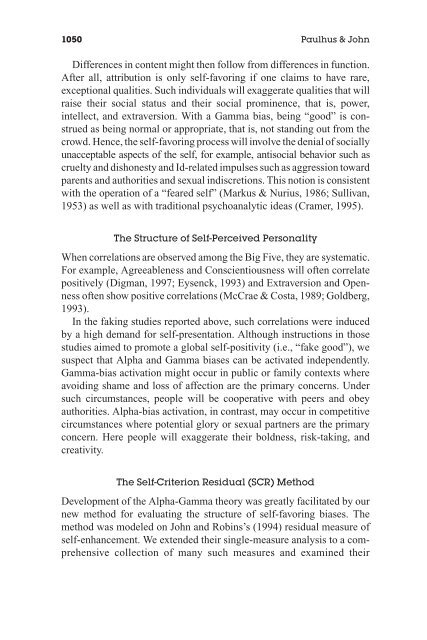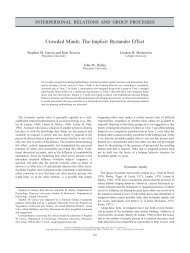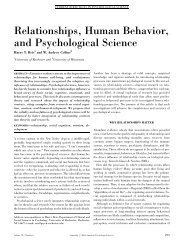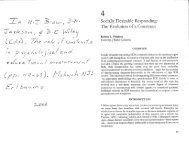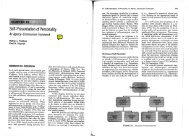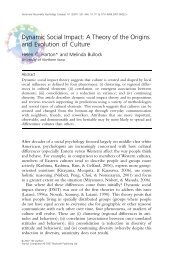Egoistic and Moralistic Biases in Self-Perception - University of ...
Egoistic and Moralistic Biases in Self-Perception - University of ...
Egoistic and Moralistic Biases in Self-Perception - University of ...
You also want an ePaper? Increase the reach of your titles
YUMPU automatically turns print PDFs into web optimized ePapers that Google loves.
1050 Paulhus & John<br />
Differences <strong>in</strong> content might then follow from differences <strong>in</strong> function.<br />
After all, attribution is only self-favor<strong>in</strong>g if one claims to have rare,<br />
exceptional qualities. Such <strong>in</strong>dividuals will exaggerate qualities that will<br />
raise their social status <strong>and</strong> their social prom<strong>in</strong>ence, that is, power,<br />
<strong>in</strong>tellect, <strong>and</strong> extraversion. With a Gamma bias, be<strong>in</strong>g “good” is construed<br />
as be<strong>in</strong>g normal or appropriate, that is, not st<strong>and</strong><strong>in</strong>g out from the<br />
crowd. Hence, the self-favor<strong>in</strong>g process will <strong>in</strong>volve the denial <strong>of</strong> socially<br />
unacceptable aspects <strong>of</strong> the self, for example, antisocial behavior such as<br />
cruelty <strong>and</strong> dishonesty <strong>and</strong> Id-related impulses such as aggression toward<br />
parents <strong>and</strong> authorities <strong>and</strong> sexual <strong>in</strong>discretions. This notion is consistent<br />
with the operation <strong>of</strong> a “feared self” (Markus & Nurius, 1986; Sullivan,<br />
1953) as well as with traditional psychoanalytic ideas (Cramer, 1995).<br />
The Structure <strong>of</strong> <strong>Self</strong>-Perceived Personality<br />
When correlations are observed among the Big Five, they are systematic.<br />
For example, Agreeableness <strong>and</strong> Conscientiousness will <strong>of</strong>ten correlate<br />
positively (Digman, 1997; Eysenck, 1993) <strong>and</strong> Extraversion <strong>and</strong> Openness<br />
<strong>of</strong>ten show positive correlations (McCrae & Costa, 1989; Goldberg,<br />
1993).<br />
In the fak<strong>in</strong>g studies reported above, such correlations were <strong>in</strong>duced<br />
by a high dem<strong>and</strong> for self-presentation. Although <strong>in</strong>structions <strong>in</strong> those<br />
studies aimed to promote a global self-positivity (i.e., “fake good”), we<br />
suspect that Alpha <strong>and</strong> Gamma biases can be activated <strong>in</strong>dependently.<br />
Gamma-bias activation might occur <strong>in</strong> public or family contexts where<br />
avoid<strong>in</strong>g shame <strong>and</strong> loss <strong>of</strong> affection are the primary concerns. Under<br />
such circumstances, people will be cooperative with peers <strong>and</strong> obey<br />
authorities. Alpha-bias activation, <strong>in</strong> contrast, may occur <strong>in</strong> competitive<br />
circumstances where potential glory or sexual partners are the primary<br />
concern. Here people will exaggerate their boldness, risk-tak<strong>in</strong>g, <strong>and</strong><br />
creativity.<br />
The <strong>Self</strong>-Criterion Residual (SCR) Method<br />
Development <strong>of</strong> the Alpha-Gamma theory was greatly facilitated by our<br />
new method for evaluat<strong>in</strong>g the structure <strong>of</strong> self-favor<strong>in</strong>g biases. The<br />
method was modeled on John <strong>and</strong> Rob<strong>in</strong>s’s (1994) residual measure <strong>of</strong><br />
self-enhancement. We extended their s<strong>in</strong>gle-measure analysis to a comprehensive<br />
collection <strong>of</strong> many such measures <strong>and</strong> exam<strong>in</strong>ed their


